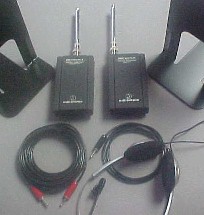2049RT
STETHOSCOPE
RECEIVER/TRANSMITTER INTERFACE
2049RT
STETHOSCOPE
RECEIVER/TRANSMITTER INTERFACE
 The 2049RT consists of a belt worn receiver (2049R) and transmitter (2049T). Initially these were components of a commercially available system but are modified significantly. The transmitter power output was increased by a factor of 6 while the receiver sensitivity improved by a factor of 10. Supplied with the system are a 20 foot transmitter to stethoscope cable (RED plugs), a 4 foot receiver to recorder cable (BLACK plugs), transmitter microphone, receiver headset and two BOOKENDS. The BOOKENDS are a very important part of the system and their use will be discussed later.
The 2049RT consists of a belt worn receiver (2049R) and transmitter (2049T). Initially these were components of a commercially available system but are modified significantly. The transmitter power output was increased by a factor of 6 while the receiver sensitivity improved by a factor of 10. Supplied with the system are a 20 foot transmitter to stethoscope cable (RED plugs), a 4 foot receiver to recorder cable (BLACK plugs), transmitter microphone, receiver headset and two BOOKENDS. The BOOKENDS are a very important part of the system and their use will be discussed later.
OPERATION: Place the stethoscope (2049M, 2047U/C) in the desired location. Plug the 20 foot cable with the RED plugs into the RECORDER output of the stethoscope and MIKE INPUT of the 2049T transmitter. Mount the transmitter on a BOOKEND and place it as far as possible from the stethoscope. Position the BOOKEND perpendicular to any over pressure area. This will allow the transmitter to fly sideways off the BOOKEND should an over pressure occur. The BOOKEND also serves to hold the transmitter antenna vertical and provide a good ground plane for maximum range.
Place the 2049R receiver on the other BOOKEND and connect it to the recorder using the 4 foot cable with BLACK plugs. Insert the black cushioned over-the-top headset into the receiver. Adjust the stethoscope for normal operation as per the instruction sheet supplied with that product. Remember, the grey headset tube goes UNDER the chin with the sound output holes facing 30 degrees forward. Once adjusted, the headset may be removed from the stethoscope. Before leaving the area... turn ON the 2049T transmitter. Turn ON the receiver and listen to the stethoscope signal. The audio level at the receiver is controlled by an automatic gain control that keeps the volume constant regardless of the input signal. Either the transmitter or receiver may be belt worn however the maximum distance may be reduced.
The receiver and transmitter are powered by 9 volt Alkaline or Lithium batteries. DO NOT use standard zinc-carbon batteries. Normal continuos battery life for the transmitter is 3 hours and for the receiver, 6 hours. As with any piece of battery operated equipment... remove the batteries during prolonged storage.
The 2049T and 2049R have 2 sets of matching frequencies.
8/09 |